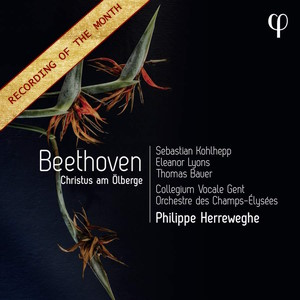
Ludwig van Beethoven (1770-1827)
Christus am Ölberge Op. 85 (1803 rev. 1804 and 1811)
Eleanor Lyons (soprano), Seraph
Sebastian Kohlhepp (tenor), Christus
Thomas Bauer (bass), Petrus
Collegium Vocale Gent
Orchestre des Champs-Élysées/Philippe Herreweghe
rec. 2022, Théâtre Auditorium de Poitiers, France
German text and English and French translations included
PHI LPH039 [48]
It is a strange thing to have to say, but here is a work of Beethoven which is both major and neglected, his only oratorio Christus am Ölberge (Christ on the Mount of Olives). It is a dramatisation of the the Agony in the Garden, the period between the Last Supper and Jesus’ arrest, when Jesus and his disciples were in the Garden of Gethsemane on the Mount of Olives. Apparently it was quite popular in the nineteenth century, but in recent times performances have become rare and there is only a handful of recordings. Maybe this is because it requires three soloists and a chorus for a work of only moderate length, meaning that a concert must contain something else as well, or maybe choral societies would rather head straight for the Missa Solemnis, despite its challenges.Beethoven wrote it in 1803, revising it shortly afterwards and again in 1811, the initial composition being in the same period in which he wrote the C minor piano concerto and the Eroica symphony. He was shortly afterwards to begin work on the opera Fidelio, which the oratorio anticipates in places. The biographically minded will also note that it was written not long after the moving document known as the Heiligenstadt Testament, the document intended for his brothers which Beethoven wrote but did not send in 1802, and in which he acknowledged his encroaching deafness; some of his grief at this disaster for his career may have prompted his choice of the subject for his oratorio and his treatment of some of it.
The libretto was by Franz Xaver Huber (1755-1814), who was best known for writing comedies and singspiels; this is the only work for which he is remembered. It may be, as the sleevenote to this recording speculates, that Beethoven was involved in planning the dramatic structure of the work and perhaps even in preparing the text. After a sombre and impressive introduction there are six main sections, each beginning with a recitative, followed variously by an aria, a chorus or sometimes both. Huber expanded the gospel narrative, with parts for a Seraph and Peter as well as Jesus. Both the text and the music are rather operatic in style, for which the work was criticized at the time. But Beethoven always intended it as a concert rather than as a church work.
In listening to this recording I was immediately impressed by the skilful shaping of the Introduction, then looked and saw that the conductor was Herreweghe, who made his name as a choral conductor renowned for his subtle phrasing. We then have the first recitative and aria, given to Jesus. Here he is cast as a tenor, an idea which made Wagner scoff, but Sebastian Kohlhepp vindicates Beethoven’s choice with his expressive and sensitive interpretation. Eleanor Lyons offers bright clear singing as the Seraph and, towards the end, Thomas Bauer is a suitably vigorous and forthright Peter, as indeed the historical Peter seems to have been. There are several choruses in which the men are variously soldiers or disciples, and the music for the soldiers has that menace characteristic of Beethoven’s march movements.
Herreweghe is clearly committed to the work and has inspired his singers and players to give of their best. The recording has been made in the sympathetic acoustic of the Théâtre Auditorium of Poitiers. The sleevenote is helpful and the full text given with translations. Despite what you may have heard about it, this is an example of first-rate Beethoven and this recording does it proud.
Stephen Barber
Help us financially by purchasing from




















